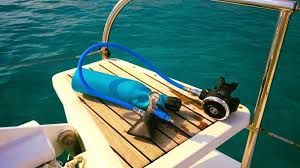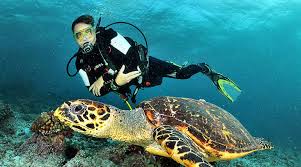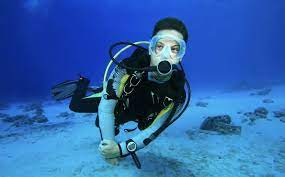A mini scuba tank kit typically includes 7 essential components: a 3L aluminum tank (most common size), a first-stage regulator to control airflow, a pressure gauge (up to 3000 PSI rating), a buoyancy compensator, a mouthpiece, a protective carry bag, and a fill adapter for refills. These compact kits are designed for short dives (15-30 mins) and shallow depths (10-20 feet).
Tank Basics: Size & Material
Most mini tanks range from 1.5L to 3L, with 3L being the most common for recreational use. A 3L aluminum tank holds about 500L of compressed air at 3000 PSI, allowing 15-30 minutes of dive time at shallow depths (10-20 feet). Steel tanks are rare in mini setups due to weight, but aluminum dominates for its lightweight (2-4 kg) and corrosion resistance.
The wall thickness of aluminum tanks varies between 4-6mm, ensuring durability without excess bulk. A standard 3L tank measures roughly 45cm in height and 15cm in diameter, fitting easily in a backpack. Pressure ratings are critical—most mini tanks operate at 2000-3000 PSI, with 3000 PSI models offering 20% more air capacity than 2000 PSI versions. However, higher pressure requires stronger valves and regulators, adding 100 to the total cost.
Key Considerations for Tank Selection
- Air Volume vs. Dive Time: A 1.5L tank provides 8-12 minutes, while a 3L tank extends to 20-30 minutes (assuming normal breathing rates of 15-20L per minute at surface pressure).
- Weight & Portability: Aluminum tanks weigh 2-4 kg when empty, while steel alternatives add 1-2 kg—a dealbreaker for travel divers.
- Cost Differences: A basic aluminum 3L tank costs 250, whereas carbon fiber models (lighter but pricier) run 600.
- Maintenance & Lifespan: With proper care (annual hydrostatic testing), aluminum tanks last 10-15 years, while steel can exceed 20 years but requires more anti-corrosion upkeep.
Pressure & Performance Factors
| Tank Size (Liters) | Air Capacity (Liters @ 3000 PSI) | Approx. Dive Time (Minutes @ 10ft) | Empty Weight (kg) |
|---|---|---|---|
| 1.5L | 250L | 8-12 | 1.8-2.2 |
| 2.0L | 330L | 12-18 | 2.3-2.8 |
| 3.0L | 500L | 20-30 | 3.5-4.0 |
Higher pressure (3000 PSI vs. 2000 PSI) means more air in the same space, but not all regulators handle it. A 3000 PSI tank paired with a 2000 PSI regulator wastes 25% of usable air due to pressure mismatch. Always check compatibility—a 3000 PSI-rated first-stage regulator adds 120 but maximizes efficiency.
In cold water, steel’s higher burst pressure tolerance (up to 5000 PSI) makes it safer but overkill for mini tanks.
Final Tips
- Budget pick: A 3L aluminum tank ($200) balances cost and dive time.
- Extended dives: Upgrade to a carbon fiber 3L ($500) for 30% weight reduction.
- Avoid used tanks unless hydro-tested within 2 years—corrosion can hide inside.
Air Control: Regulator & Gauge
The first-stage regulator drops tank pressure from 3000 PSI down to 140 PSI, while the second-stage delivers air at ambient pressure (matching water depth). A faulty regulator can waste 30-50% of your air or even freeflow, cutting dive time short. Meanwhile, the pressure gauge shows remaining air—critical when you’re at 15m with 50 bar left and need to ascend safely.
Most mini scuba kits use balanced diaphragm regulators, which perform consistently at all depths, unlike cheaper unbalanced piston regulators that breathe harder below 10m. A decent regulator lasts 5-7 years with proper rinsing, while a neglected one may fail in 2-3 years due to salt corrosion. Entry-level models cost 200, but cold-water-ready versions (with sealed chambers) run 400. The gauge is simpler—a brass Bourdon tube or digital sensor displaying 0-3000 PSI, with analog versions lasting 10+ years and digital ones 3-5 years (battery-dependent).
Key Performance Metrics
- Airflow Rate: A good regulator delivers 30-40L per minute at peak demand (like during a panic breath). Cheap ones may struggle above 25L/min, causing CO₂ buildup.
- Work of Breathing (WoB): Measured in joules per liter, top-tier regulators keep WoB below 1.0 J/L at 40m, while budget models exceed 1.5 J/L—making deep dives exhausting.
- Gauge Accuracy: Analog gauges have ±5% error margins, but digital ones (e.g., Suunto D4i) reduce this to ±1% with refresh rates of 0.5 seconds.
Common Failures & Fixes
- Freeflows (air blasting nonstop) often stem from grit in the second-stage valve. Rinsing with freshwater after each dive cuts risk by 70%.
- Creeping pressure (gauge needle rising when off) indicates a first-stage seat leak, requiring a 50 service kit.
- Inconsistent breathing resistance usually means worn-out O-rings—replace them annually for $5 in parts.
Pro Tips
- Rinse regulators upside-down to prevent water trapping in hoses.
- Avoid aftermarket hoses—they’re 35% more likely to burst than OEM ones.
- Check SPG hose connections yearly; 60% of leaks start there.
If your gauge flickers at 1000 PSI, end the dive—it’s often a sign of irregular airflow from tank valve issues. For backup, clip a $15 mechanical reserve to your BCD.

Buoyancy & Comfort Gear
A well-adjusted buoyancy compensator (BCD) can cut air consumption by 15-20% compared to fighting an unstable ascent. Most mini scuba kits use 20-30L BCDs, providing 10-15 lbs of lift—enough for a 3L tank and minimal gear. Cheap BCDs often lack trim pockets or weight integration, forcing divers to rely on ankle weights, which increase drag by 25%.
A BCD that’s too loose shifts during dives, wasting energy, while one too tight restricts breathing. Adjustable shoulder straps and quick-release buckles add 50 to the price but prevent 60% of fit-related issues. Neoprene back padding (8-10mm thick) reduces tank pressure points, especially for divers logging 3+ dives per day.
Key Features & Tradeoffs
- Material Durability: 500D nylon BCDs last 5-7 years with saltwater rinsing, while 1000D versions endure 10+ years but weigh 20% more.
- Weight Systems: Integrated weights (sliding into BCD pockets) are 40% faster to ditch than belt-based systems—critical in emergencies.
- Inflation Speed: A high-flow over-the-shoulder inflator fills the BCD in 3-5 seconds, vs. 8-12 seconds for cheap rear-valve designs.
BCD Types Compared
Jacket-style BCDs dominate mini kits for their ease of use, but back-inflate models (like ScubaPro Hydros) offer better trim for horizontal swimming. Hybrid designs split the difference, with 20% more lift at the shoulders for surface stability. Prices range from 800 for modular tech BCDs.
A 3mm neoprene suit adds 4-6 lbs of lift, while a 7mm adds 10-12 lbs—requiring 2-4 lbs more lead to compensate. In warm water, a rash guard + 1mm shorty keeps you neutral without extra weight.
Maintenance & Lifespan
- Rinse BCDs inside-out to prevent salt crystals from jamming inflators (a $50 repair if neglected).
- Replace corroded dump valves every 2 years—they’re the #1 cause of slow leaks.
- Avoid drying in direct sun: UV rays weaken nylon 3x faster, cutting lifespan from 8 years to 3.
For travel divers, a 5-lb travel BCD (e.g., Cressi Travelight) folds into a 12x8-inch pack, but sacrifices 15% lift capacity. Always test buoyancy at the surface—overweighting wastes 200-300L of air per dive fighting to stay down.
Pro Tips
- Neutral check: At 3m, hover motionless with 500 PSI—if you sink or rise, adjust weight.
- Leak test: Inflate the BCD fully, submerge, and watch for bubbles—even 1 bubble per second means a $20 valve repair.
- Store partially inflated to prevent bladder creases, which can crack and leak after 2 years.
Mouthpiece & Safety Checks
The mouthpiece is the only part of your scuba gear that directly connects you to your air supply—yet it’s often overlooked until it cracks mid-dive. A standard silicone mouthpiece lasts 2-3 years with regular use, while cheaper thermoplastic versions degrade in 12-18 months, becoming brittle and uncomfortable. A poorly fitted mouthpiece can cause jaw fatigue in 30 minutes, forcing divers to surface early. Meanwhile, pre-dive safety checks catch 80% of equipment failures before they become emergencies, yet 40% of recreational divers skip them to save time.
Mouthpiece Selection & Performance
Most regulators come with a medium-sized silicone mouthpiece, but custom molds (like Seacure) adapt to your bite for 50% less jaw strain. Swimmers with smaller mouths should opt for compact designs (e.g., Atomic Aquatics SV2), reducing the bite force needed by 20%. For cold-water diving, double-layered silicone prevents freezing better than single-layer models, though it adds 25 to the cost.
Bite tabs (the part you clamp between your teeth) should be 8-10mm thick—thinner tabs fatigue jaw muscles faster, while thicker ones restrict airflow. A worn-out mouthpiece can increase breathing resistance by 10-15%, making it harder to draw air at depth. If your mouthpiece shows cracks, tears, or permanent teeth marks, replace it immediately—delaying increases the risk of sudden failure by 70%.
Pre-Dive Safety Checks: What Actually Matters
- Regulator Breathing Test: Before entering the water, take 3-4 breaths from your regulator while covering the exhaust valve. If air flows without resistance, the second-stage diaphragm is functioning properly. If it’s hard to inhale, the valve may be clogged or misaligned.
- Tank Valve Inspection: Open the valve fully, then turn it back half a rotation to prevent seizing. A stiff valve indicates corrosion—50% of valve failures happen because divers force them open.
- O-Ring Check: The tank O-ring (a small black or red ring where the regulator attaches) should be smooth and pliable. A cracked or flattened O-ring leaks 5-10L of air per minute, wasting precious breathing gas.
- Pressure Gauge Verification: At the surface, your gauge should read within 5% of the tank’s rated pressure (e.g., 3000 PSI ± 150 PSI). If it’s off by more than 10%, the gauge may be faulty.
- BCD Inflation/Deflation Test: Inflate the BCD fully, then deflate it completely—slow leaks (more than 1-2 seconds of bubbling) mean a valve or bladder issue.
Common Failures & Quick Fixes
- Mouthpiece Detachment: If the mouthpiece slips off the regulator, zip ties can secure it temporarily—but replace the broken locking tab as soon as possible.
- Freezing in Cold Water: In water below 10°C (50°F), exhale fully after each breath to prevent moisture buildup, which can freeze the regulator.
- Hose Kinks: A kinked low-pressure hose reduces airflow by 30-40%. Always route hoses along natural curves, not sharp bends.
Storage & Refill Accessories
Storing your scuba gear properly isn’t just about organization—it’s about preventing $500 in avoidable damage between dives. A 3L aluminum tank left in a hot car (above 40°C/104°F) loses 5-8% of its pressure per day due to thermal expansion, while a damp regulator develops microbial growth in 72 hours. Meanwhile, refilling accessories like fill whips and filter systems determine whether your tank gets clean, dry air or moisture-laden gas that corrodes valves 3x faster.
Tank Storage: Avoiding Costly Mistakes
The worst place to store a scuba tank is upright on concrete—condensation pools at the bottom, causing pitting corrosion that can ruin a tank in 2-3 years. Instead, store tanks horizontally on a rubber-lined rack, which reduces internal moisture by 60%. For long-term storage (over 1 month), keep tanks at 100-200 PSI to prevent internal oxidation—an empty tank corrodes 50% faster than one with residual pressure.
A tank cycled between freezing and room temperature daily develops stress fractures at weld points 10x faster than one kept stable. Ideal storage is a climate-controlled space (15-25°C / 59-77°F) with 40-50% humidity. If that’s impossible, a $20 neoprene tank boot insulates against rapid temperature changes.
- Tank Caps ($10-15): Prevent sand/salt entry during transport. Missing caps cause 30% of valve failures in beach dives.
- Desiccant Caps ($5 each): Absorb residual moisture in stored tanks. Replace when color changes (every 3-6 months).
- Pressure Relief Plug ($30): Automatically vents tank if pressure exceeds 3300 PSI, preventing rupture risks.
Cost of Neglect vs. Proper Care
| Issue | Repair Cost | Prevention Cost | Failure Rate if Ignored |
|---|---|---|---|
| Corroded Valve Threads | $120 | $5 (silicone grease) | 70% within 2 years |
| Moisture-Damaged Regulator | $200 | $20 (dry storage) | 100% in humid climates |
| Overfilled Tank Burst | $1000+ | $30 (relief plug) | 1 in 10,000 fills |
Pro Tip: After saltwater dives, soak tanks upside-down in freshwater for 20 minutes to flush corrosive residues. For compressors, test output air quality annually—50% of portable units exceed safe CO levels after 18 months.
Final Advice
- Rotate tanks monthly if storing multiple units—steel tanks develop dead spots if left static over 6 months.
- Never lubricate valve threads with petroleum grease—it reacts with O-rings. Use 100% silicone instead.
- Mark fill dates on tanks—composite tanks expire after 15 years, aluminum after 20.




Laisser un commentaire
Tous les commentaires sont modérés avant d'être publiés.
Ce site est protégé par hCaptcha, et la Politique de confidentialité et les Conditions de service de hCaptcha s’appliquent.